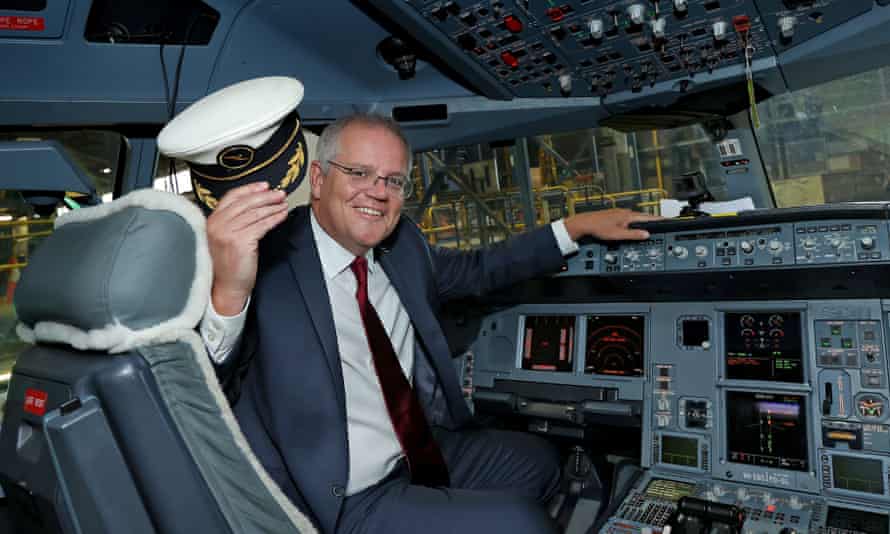Extract from The Guardian
Grogonomics Australian economy
The regions targeted in the stimulus are actually holding up better than are capital cities when it comes to visitors spending money

Last modified on Tue 16 Mar 2021 03.33 AEDT
One of the overriding problems with the Morrison government is it is led by a man clearly more focused on the announcement and the photo op than the policy. This was certainly the case last week when Scott Morrison announced cheap air fares in order, he said, to help tourist areas cope with the lack of international visitors.
While marketing of good policy can be quite useful, marketing instead of policy is invariably not. It always leads to bad policy; policy devised for no purpose other than to win votes and give the prime minister a chance to have his photo taken standing next to some prop.
It’s usually not so clear as was the case last week with the announcement of the Tourism Aviation Network Support package which involves subsidising 800,000 airline tickets to 13 destinations around the country.
So carefully crafted was the policy that they left off Adelaide and Darwin in the announcement, and didn’t make it clear if “Tropical North Queensland” meant just Cairns, or Townsville as well (it didn’t but then by Friday, it did).
Just minor details, I guess.
But what immediately became clear is that these 13 locations selected for the cheap flights were curious.
Morrison, while standing next to the very happy CEOs of Qantas and Virgin Australia, stated that “in the tourism sectors, we know it will continue to be tough, particularly in those parts of the country most reliant on international tourism and that’s why today we have brought together … this package, which gives a shot in the arm to the travel, tourism and the aviation sector”.
So right there in the announcement was the link between the fall in international travel and this new package.
As such it was rather weird that except for Melbourne via Avalon airport (why Avalon and not Tullamarine?), the four major destinations by international travellers were not included:
Graph not displaying? Click here
And it didn’t include the New South Wales north coast – such as Coffs Harbour – but it did include Merimbula airport on the NSW south coast.
But why?
OK. Let’s say you want to go on a holiday. You want somewhere peaceful, near beautiful beaches and where whale watching is possible.
Sounds great – Albany, Western Australia is just the place.
However, under the government’s tourism package you can get cheap flights to Merimbula, but not to Albany, despite many more people being able to get to Merimbula by car and both airports getting around the same numbers of travellers:
Graph not displaying? Click here
It also has more travellers using its airport than Merimbula.
But sorry, no cheap flight there.
Same with Mildura. It’s also a lovely place to holiday – no whales, but the River Murray is (I speak from experience) a great place to unwind.
Its airport also gets about 150,000 travellers more a year than Merimbula, and has suffered much the same percentage fall in numbers as the NSW south coast destination.
Nope, sorry it misses out.
This is not to bag Merimbula, but to highlight that there really is no logic to the government’s policy – unless you might think that Merimbula sitting in a marginal seat, while Albany, Mt Gambier and Mildura do not, is logic enough.
But the problem with the policy is that not only are the regional locations not really the main destinations of international travellers, but that the regions are actually holding up better than are capital cities when it comes to visitors spending money:
Graph not displaying? Click here
As economist Scott Steel noted on Twitter, regional Western Australia, South Australia and Queensland all took in more money from domestic visitors in December 2020 than they did in December 2019.
But the areas that have suffered the biggest drop in visitor spending are the capital cities.
Why? Because capital cities are the places most people go for holidays, they are where most people live so that’s where most people go to visit relatives and friends, and that is where most businesses are and so that is where most business trips are.
Now sure, these cheap tickets will be snapped up, and the government will claim that as a win, but a look at the passenger number at Sydney airport (which is not a destination that receives a cheap trip) shows just how misguided this policy really is:
Graph not displaying? Click here
Compared to 2019, domestic passengers in December last year were down 71% and international passengers were down 97%.
That would suggest to me a traveller destination in need of assistance.
But I guess not enough of the tourism areas of Sydney are in marginal seats.
No comments:
Post a Comment